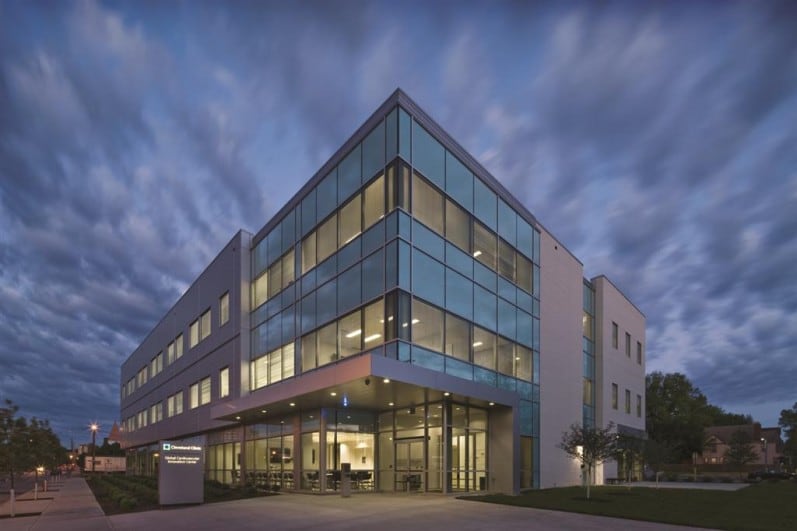Here in the early 21st century, we’re transitioning between two periods: the past, built from tradition and brick, and the future, which will run on innovation and technological advancement. Straddling these two eras, how can today’s healthcare facilities keep up with the pace of innovation?
We just might find our perfect role model in the progressive strategies and innovation-focused culture of the Cleveland Clinic. At the Health Facilities Innovation Forum (now HealthSpaces), Frank Aucremanne, Executive Director of Real Estate, Facilities & Construction, walked us through many of the initiatives that the Cleveland Clinic is taking to stay nimble and nurture a culture of innovation despite its large size...
Leveraging Staff Expertise & Technology
To position itself for success in the ever-changing healthcare marketplace, Cleveland Clinic built an entire “innovation center” in 2000, which is dedicated to developing medical breakthroughs and inventions. They leverage the expertise of their physicians and researchers to farm ideas ripe for commercialization.
 |
Through this center, the clinic has made over 3,600 patent applications and obtained more than 1,200 patents. About 50% of these patents are for medical devices, while much of the rest consists of health IT, therapeutics, and diagnostics. These developments are integral to driving the clinic forward in its advancement.
Augmedix - Google Glass
Aucremanne highlighted one of the wow-worthy inventions coming out of the innovation center: the Augmedix Google Glass. When providers wear these smart glasses during patient visits, a remote team watches in real-time and updates the patient’s health records with new information. This innovation allows doctors to spend less time updating EMRs themselves and spend more time attending to patients. Given that doctors tend to spend twice as much time manually updating EMRs as they do with patients, this tool is extremely valuable for improving healthcare efficiency.
IBM Watson Health
As of 1921, healthcare knowledge doubled every 150 years. By 2020, it will double every 73 days. Today’s doctors just can’t keep up with the overwhelming mass of knowledge needed to treat patients effectively-- at least not without technological help.
The Cleveland Clinic has partnered with IBM Watson to assist in the mission of harnessing big data assets. Watson is a powerful cognitive computing platform that can read through 40 million documents in just 15 seconds. When applied to medicine, the supercomputer can quickly filter through symptoms and speed up the diagnosis process.
This tech is so important for medical advancement that the Cleveland Clinic is dedicating an entire campus facility to IBM Watson. Aucremanne highlighted how the clinic expects to benefit greatly from the presence of coders and analysts, who will be working alongside physicians, looking at data and patient outcomes in real time.
How Healthcare Trends are Influencing Facility Design
Aucremanne emphasized that the shifting dynamics of the healthcare landscape are directly influencing how Cleveland Clinic is serving its patients.
Outpatient visits have gone up, as well as the demand for immediacy and accessibility. The clinic is responding by strategically closing certain inpatient facilities and adding smaller outpatient establishments that focus on primary care and family medicine.
Express and urgent care visits are rising steeply too, but the low margins of these facilities make developing them tricky. Because the market is changing so quickly, many of these stations may be obsolete within a 5-year span. The clinic is, therefore, taking a cautious approach, designing these facilities to be flexible and placing them in prime locations where ROI can be secured easily.
Distance health is one of the strongest rising trends and is being applied by the clinic to both inpatient and outpatient visits, minor and serious. This is provided in the form of eVisits and virtual appointments. For common, minor ailments, distance health is able to keep patients out of the hospital. This allows the clinic lower healthcare costs and frees up space in facilities for those who need it most.
Bringing Facilities Management & Staff Training into the Future
Using tech to interact with and manage patients isn’t only happening with distance health. The clinic is also sweeping through its facilities and integrating high-tech systems.
During their recent eHospital update, the clinic doubled the size of their ICU command center, digitizing most processes and improving efficiency. Interactive patient rooms have been installed, featuring remote monitoring and cameras so sophisticated that they’re able to see how dilated a patient’s pupils are. These advancements are enabling hospital staff to stay on top of patient care and be more responsive.
One question that Aucremanne posed was how facilities managers can use innovation to reduce the costs of building operations. At the clinic, they’re using BAS integration to build enterprise and facilities management command centers.
This includes the creation of a system health dashboard, which allows them to visually track each building’s energy performance in real time. Color coding identifies which buildings are consuming more energy than they should, making it easy for the clinic to identify which parts of their facilities need attention.
Health Education Campus
The Cleveland Clinic is currently in the process of building its Health Education Campus, where students will be taught in state of the art environments with the most advanced technologies available. These technologies include a 3D HoloLens-- an augmented reality headset that allows students to work on life-sized virtual cadavers.
Adopting the HoloLens was actually a choice driven by efficiency concerns. Traditional medical training centers use cadavers for anatomical education. However, the presence of these cadavers requires heavy duty air control, which can be shockingly expensive. By opting for a cadaver-less, futuristic way of learning, the clinic has been able to design a facility that saves energy without compromising education quality.
Join us at HealthSpaces for more on innovations in healthcare facilities planning, design and construction.

Posted by
Collaborate with your Peers!
HealthSpaces is a community for people that plan, design, build and operate spaces where healthcare is delivered.
June 7-9, 2026 | Braselton, GA
Learn More




-4.png)
-Dec-09-2025-05-48-44-4379-PM.png)
-4.png)
-1.png)
-2.png)

Comments